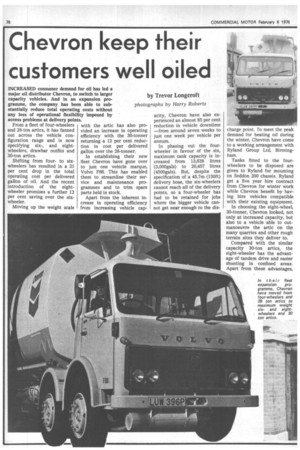Chevron keep their customers well oiled
Page 80

Page 81

If you've noticed an error in this article please click here to report it so we can fix it.
INCREASED consumer demand for oil has led a major oil distributor Chevron, to switch to larger capacity vehicles. And in an expansion programme, the company has been able to substantially reduce total operating costs without any loss of operational flexibility imposed by access problems at delivery points.
by Trevor Longcroft
photographs by Harry Roberts From a fleet of four-wheelers and 28-ton artics, it has fanned out across the vehicle configuration range and is now specifying six-, and eightwheelers, drawbar outfits and 30-ton artics.
Shifting from fourto sixwheelers has resulted in a 21 per cent drop in the total operating cost per delivered gallon of oil. And the recent introduction of the eightwheeler promises a further 12 per cent saving over the sixwheeler.
Moving up the weight scale with the artic has also provided an increase in operating efficiency with the 30-tonner returning a 12 per cent reduction in cost per delivered gallon over the 28-tonner.
In establishing their new fleet Chevron have gone over to just one vehicle marque, Volvo F86. This has enabled them to streamline their service and maintenance programmes and to trim spare parts held in stock.
Apart from the inherent increase in operating efficiency from increasing vehicle cap acity, Chevron have also experienced an almost 85 per cent reduction in vehicle downtime —from around seven weeks to just one week per vehicle per annum.
In phasing out the fourwheeler in favour of the six, maximum tank capacity is increased from 13,638 litres (3,000gals) to 20,457 litres (4500gals). But, despite the specification of a 45.7m (150ft) delivery hose, the six-wheelers cannot reach all of the delivery points, so a four-wheeler has had to be retained for jobs where the bigger vehicle cannot get near enough to the dis charge point. ro meet the peak demand for heating oil during the winter, Chevron have come to a working arrangement with Ryland Group Ltd, Birmingham.
Tanks fitted to the fourwheelers to be disposed are given to Ryland for mounting on Seddon 200 chassis. Ryland get a five year hire contract from Chevron for winter work while Chevron benefit by having hire vehicles compatible with their existing equipment.
In choosing the eight-wheel, 30-tonner, Chevron looked, not only at increased capacity, but also to a vehicle able to outmanoeuvre the artic on the many quarries and other rough terrain sites they deliver to.
Compared with the similar capacity 30-ton artics, the eight-wheeler has the advantage of tandem drive and easier shunting in confined areas. Apart from these advantages, the eight-wheeler can carry up to 22,730 litres (5,000gals) of any of the oils handled by the fleet and is used for jobs which previously required two of the lighter vehicles.
Chevron regard the F86 tractive unit as ideal for 30-ton operation. But, at least for their own services, they do not feel that it has the performance for running at 32.5 tonnes (32 tons) gcw.
The increase in gross combination weights has been accomplished without changing trailers. At the lower weight, the trailers were down plated to 23.6 tonnes (23.2 tons) gtw; they have simply been replated to their original design plating, 27.9 tonnes (27.5 tons) gtw.
The extra two tons on gross weight permits a further 1,363 litres (300gals) of the heavier gas oils to be carried, making the total capacity 22,730 litres (5,000gals), though there is no increase in lighter oil capacity, which remains at 22,730 litres (5,000gals).
Lubricating oil deliveries are made from one of two ware houses rather than oil terminals and the four-wheeler originally specified is being phased out in favour of drawbar outfits.
Prior to the " dangler," the company used a four-wheeler on contract hire but when large consignments were ordered, they had to spot hire an artic, leaving the rigid idle. The drawbar gives the best of both worlds with the added advantage over the artic, of being able to split for entry into tight spaces or areas having weight restrictions. For instance, when delivering lubricating oil to ships on the jetty side, the load can be delivered in two shifts to avoid exceeding jetty weight limits. The prime mover only is discharged first and then returns to its trailer, takes on the oil from the trailer, and then returns for a second delivery.
For smaller consignments, the rigid is used on its own and because it is designed for operation at 32.5 tonnes (32 tons) gcw it gives a superior performance to a standard 16tonner.
































































































































